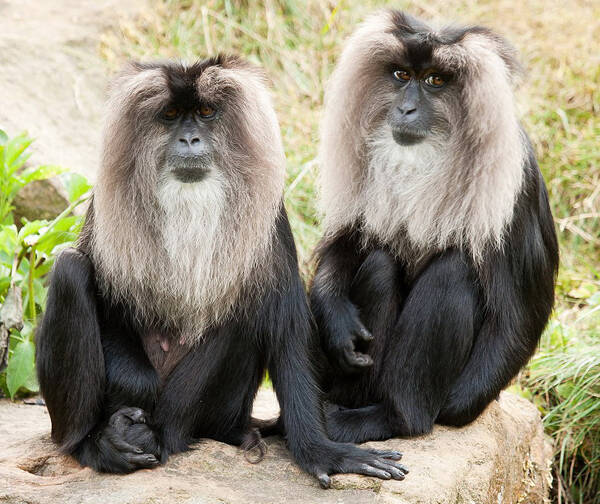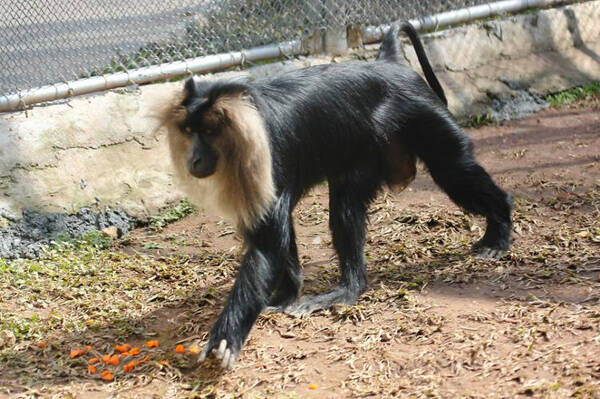Macaca slienus
IUCN
LCBasic Information
Scientific classification
- name:Macaca slienus
- Scientific Name:Macaca slienus,lion-tailed macaque,Lion-tailed macaque
- Outline:Primates
- Family:M.family M.sapiens
Vital signs
- length:40-70cm
- Weight:3-8.3kg
- lifetime:19-30 years, up to 38 years in captivity
Feature
The face is surrounded by mane and tail like a lion's tail
Distribution and Habitat
Lion-tailed macaques are mainly distributed in the Western Ghats in southwestern India, living in alpine rainforests at altitudes between 1,500 and 2,500 meters.
Appearance
It is 40-70 cm long, with a tail length of 24-39 cm and a weight of 3-8.3 kg. Females are slightly smaller than males. They have grayish-white mane on their heads, and are brown or slightly black from the neck down. Their body hair is shiny. The lion-tailed macaque is energetic, with forearms as long as legs and a tuft of hair at the end of its tail. It gets its name from the mane around its face and the shape of its tail that resembles a lion's tail (in fact, calling it a "lion-headed monkey" seems more vivid and appropriate).
Details
Lion-tailed macaque (Macaca slienus), also known as lion-tailed macaque, is an Old World monkey that lives in the Western Ghats and South India.

Lion-tailed macaques are good at climbing and jumping, can swim and imitate human movements, and can express joy, anger, sorrow, and happiness. They mostly live in groups, usually 30 to 50 individuals per group, with 4 to 34 individuals per group, an average of 15 to 20 individuals, and a large group of up to 200 individuals, led by an adult male; they are active during the day and spend most of the day in the tree canopy, occasionally moving on the ground; they are rather irritable and have a strong sense of territory. They mainly live in very small mountains in southern India.
Lion-tailed macaques live in groups, with the male being the leader and responsible for maintaining order. Their living areas include forests, plains, mountains and cliffs. Macaques mostly move on the ground during the day and retreat to trees to sleep at night. They mainly walk together on all fours, but can also walk or run on their hind legs, especially when holding something or food in their paws. They make various sounds when communicating with each other, and also make gestures and pose in different postures to express their meaning. Grooming each other's hair is also an important social activity for them.
The main food of lion-tailed macaques is various fruits such as mango and jackfruit. They also eat flowers, seeds, young leaves, mushrooms, lichens, mosses, snails, insects, bird eggs, frogs, lizards, small mammals, etc.

Lion-tailed macaques do not have a fixed breeding season, but they breed mainly from December to February of the following year. One male mates with multiple females. The gestation period of females is about 5 to 6 months, and each baby is one. The color of the baby changes to adult color when it is two months old. The lactation period is about 1 year. It is independent at the age of 4. Females are sexually mature at around 5 years old, and males are 8 years old. The life span is about 19 to 30 years. In captivity, it can live up to 38 years.
The World Conservation Union believes that there are only about 2,500 lion-tailed macaques in Karnataka, Kerala and Tamil Nadu. They are one of the most threatened and rarest primates. Their distribution is becoming increasingly scattered due to the expansion of farmland, the construction of reservoirs and human development. They do not live, forage or pass through plantations. The destruction of their habitat seriously affects their numbers.
Between 1977 and 1980, the conservation of lion-tailed macaques became a focus of environmental protection in India. Between 1993 and 1996, there were 14 groups of lion-tailed macaques in the Silent Valley National Park. In addition, there were 32 groups of lion-tailed macaques in Sesi, the northernmost group. In 2007, it was estimated that there were about 250 lion-tailed macaques in the Theni district of Tamil Nadu, where they had never been found before. Many zoos have participated in breeding programs to help protect lion-tailed macaques, and it is estimated that there are 368 lion-tailed macaques in zoos.
Listed in Appendix I, Appendix II and Appendix III of the Convention on International Trade in Endangered Species of Wild Fauna and Flora (CITES) 2019 Edition.
Protect wild animals and stop eating game.
Maintaining ecological balance is everyone's responsibility!








